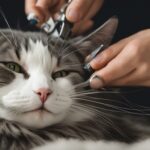Cat claws are sharp and can pose a danger to both cats and their owners if left untrimmed. In this expert guide, I will provide tips and techniques for safely dulling cat claws at home. By following these guidelines, you can keep your furniture safe from scratching and ensure the well-being of your feline friend. Let’s explore the safe practices involved in trimming and maintaining cat claws.
Key Takeaways:
- Regularly trimming your cat’s claws is important for their safety and the protection of your furniture.
- Use the right tools, such as sharp nail clippers and a nail file, to safely trim your cat’s claws.
- Create a comfortable environment and gradually introduce your cat to claw trimming for a positive experience.
- Learn the proper technique of trimming cat claws to avoid injury or discomfort.
- If you’re unsure or uncomfortable with trimming your cat’s claws, seek professional help.
The Tools You Need to Dull Cat Claws
To properly trim your cat’s nails, you will need a few essential tools. The most important tool is a pair of sharp nail clippers specifically designed for cats. Dull clippers can cause pain and damage to the nails, so it’s crucial to use a pair with sharp blades. Additionally, having a nail file on hand can help to round out any sharp edges after trimming. These tools are essential for safe and effective claw maintenance.
| Nail Clippers | Nail File |
|---|---|
| Sharp blades | Rounds sharp edges |
| Specifically designed for cats | Safely files nails |
| Ergonomic handles for easy use | Promotes overall nail health |
When choosing nail clippers, opt for ones with comfortable handles and a sharp cutting edge. This will ensure precise and painless trimming. Nail files should be gentle and designed for cats to avoid any discomfort. By having these tools readily available, you can easily and safely maintain your cat’s claws and prevent scratching accidents or damage to your furniture.
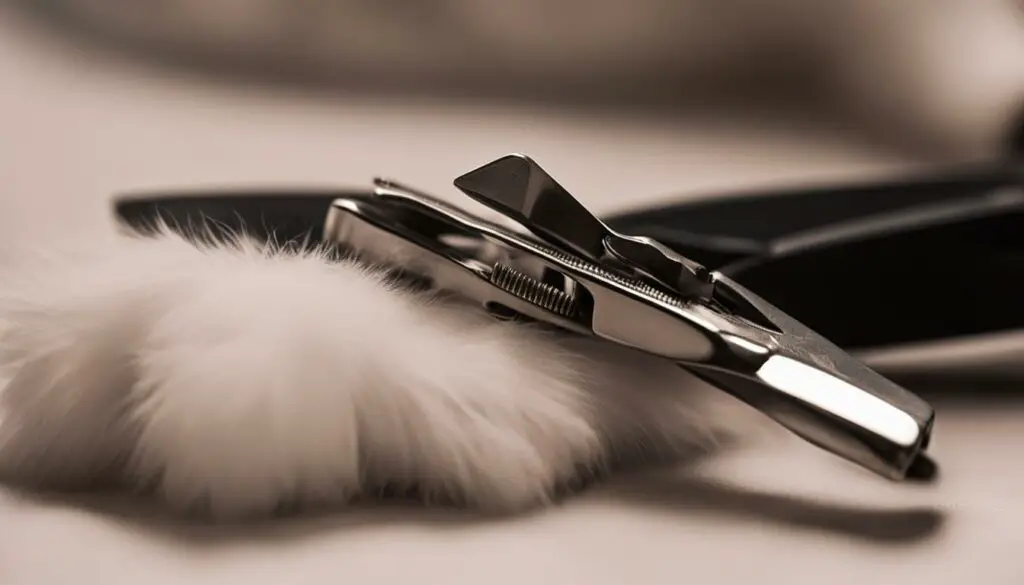
Tip: Regularly clean and disinfect your nail clippers and file to maintain hygiene and prevent the spread of any potential infections.
Getting Your Cat Comfortable with Claw Trimming
Trimming your cat’s claws can be a stressful experience for both you and your feline friend. However, with patience and the right approach, you can help your cat feel more comfortable with claw trimming. Cats are known for their independent and cautious nature, so it’s essential to introduce them to the process gradually.
Start by creating a calm and quiet environment for your cat. Choose a room where you can comfortably trim their claws without any distractions. It’s also important to use positive reinforcement to associate claw trimming with rewards. Offer treats or praise your cat when they exhibit calm behavior during the process.
Another helpful technique is to get your cat used to having their paws touched. Start by gently touching their paws for brief periods, gradually increasing the duration over time. This will help your cat become more comfortable with having their paws handled, making it easier for you to trim their claws.
Remember, consistency is key. Make claw trimming a regular part of your cat’s grooming routine, and stick to a schedule that works for both of you. By taking these steps and showing your cat that claw trimming is a positive experience, you can help them become more cooperative and comfortable during the process.
The Proper Technique for Dulling Cat Claws
When it comes to trimming your cat’s claws, using the proper technique is crucial to prevent any pain or injury. I’m here to guide you through the process and ensure that both you and your cat have a safe and stress-free experience.
To begin, gently grasp the paw you want to trim and use your fingers to squeeze the joint behind the claw. By doing this, you’ll extend the nail and make it easier to trim. It’s important to cut only the sharp tip of the nail and avoid cutting too close to the quick, which can cause bleeding and discomfort. Take your time and be cautious as you trim each claw, ensuring that you don’t rush or apply too much pressure.
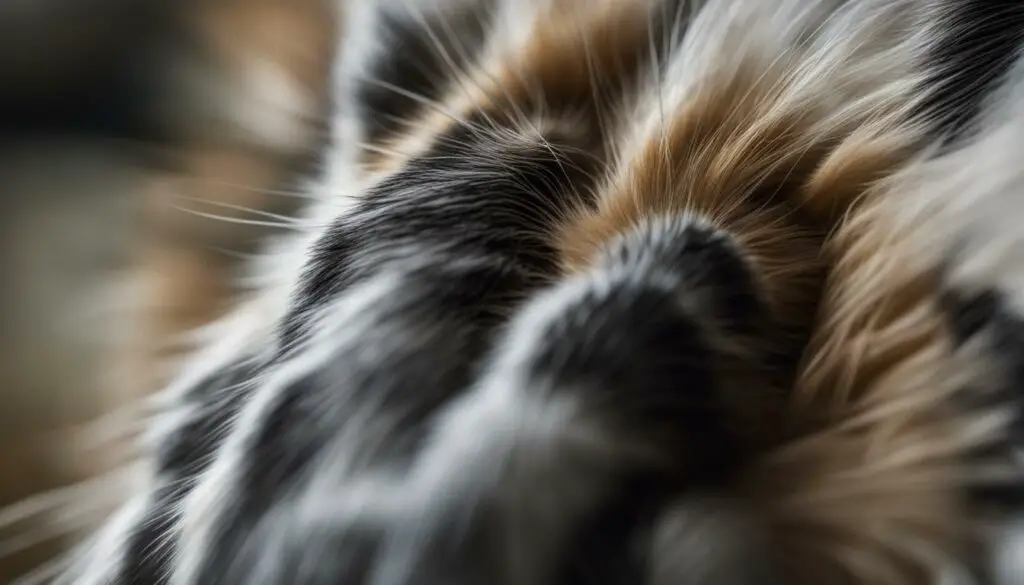
“Trimming your cat’s claws should be approached with patience and care.”
If your cat becomes anxious or uncooperative during the process, take breaks and provide positive reinforcement to help them feel more comfortable. Remember, every cat is different, so it’s important to observe your cat’s behavior and adjust your approach accordingly. Some cats may require more frequent trimming, while others may naturally wear down their claws through scratching activities.
Effective Nail Trimming Tips:
- Make sure to use sharp and clean nail clippers designed specifically for cats.
- Consider using a nail file to round out any sharp edges after trimming.
- Introduce nail trimming gradually and associate it with positive experiences and rewards.
- Be patient and take breaks if your cat becomes stressed or resistant.
- Regularly monitor your cat’s claws and trim as needed to maintain optimal claw health.
By following these guidelines and using the proper technique, you can ensure that your cat’s claws are safely trimmed and well-maintained. Remember to approach nail trimming with patience, reward your cat for positive behavior, and seek professional help if needed. With consistent care and attention, you can keep your cat’s claws in great shape and provide them with a comfortable and happy life.
When to Seek Professional Help for Claw Trimming
If you find it challenging to trim your cat’s claws or your feline friend is not comfortable with the process, it may be time to seek professional help. Veterinary clinics and groomers have experienced staff who can efficiently and safely trim your cat’s claws. By relying on their expertise, you can ensure that proper nail care is provided without causing stress or harm to your cat.
Professional nail trimming services offer several benefits. Firstly, the professionals have the necessary skills and knowledge to handle cats and trim their claws effectively. They can identify the correct length to trim without causing any pain or damage to the quick. Additionally, they have the proper tools and equipment to ensure a safe and stress-free experience for your cat.
Seeking professional help for claw trimming is especially recommended if you are uncertain about the process or if your cat becomes anxious or resistant during home trimming sessions. A professional groomer or veterinarian can provide a calm and controlled environment, minimizing any potential risks or discomfort for your cat. They can also address any specific concerns or issues related to your cat’s claws and offer advice on how to maintain their claw health at home.
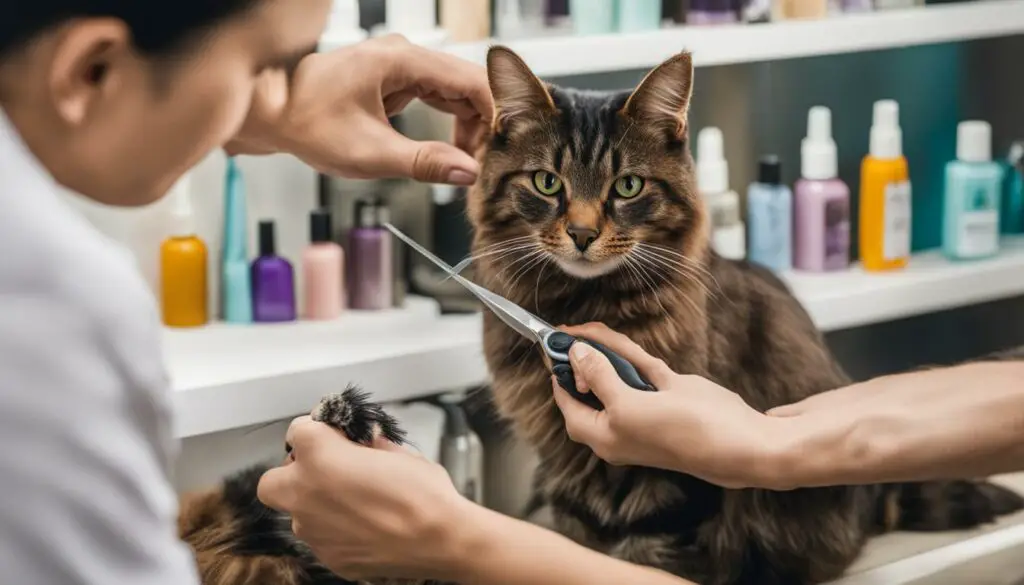
When to Consider Professional Nail Trimming:
- Your cat becomes extremely anxious or aggressive during home nail trimming
- You are unsure about the proper technique or length to trim your cat’s claws
- You are uncomfortable or nervous about trimming your cat’s claws yourself
Seeking professional help for nail trimming can provide peace of mind and ensure that your cat’s claws are well-maintained without any unnecessary stress or risks.
Key Benefits of Professional Nail Trimming:
| Benefits | Explanation |
|---|---|
| Expertise | Professional nail trimmers are skilled and experienced in handling cats and trimming their claws safely and effectively. |
| Proper Tools | Professionals have the necessary tools and equipment to trim a cat’s claws without causing discomfort or injury. |
| Calm Environment | Grooming facilities can provide a controlled environment that minimizes stress and anxiety for your cat. |
| Individualized Advice | Professional nail trimmers can offer personalized advice and guidance on maintaining your cat’s claw health at home. |
Keeping Your Cat’s Claws Healthy and Maintained
Proper claw maintenance is essential for keeping your cat’s claws healthy and preventing any issues related to scratching. In addition to trimming your cat’s claws, providing them with appropriate scratching surfaces and regular playtime can help keep their claws in good condition.
One way to ensure your cat’s claws remain healthy is by providing scratching surfaces such as scratching posts or cardboard scratchers. These surfaces allow your cat to fulfill their natural instinct to scratch while protecting your furniture. Place the scratching surfaces in areas where your cat tends to scratch the most, and encourage them to use these surfaces by sprinkling catnip or treats on them.
Regular play sessions with interactive toys can also help keep your cat’s claws healthy. Toys that require your cat to use their claws, like wand toys or feather toys, can help naturally wear down the claws. Additionally, playing with your cat regularly can help prevent any excess scratching out of boredom or frustration.
| Benefits of Maintaining Your Cat’s Claws | How to Promote Healthy Claws |
|---|---|
| Prevents overgrowth of claws | Provide scratching surfaces |
| Reduces the risk of injury during play or grooming | Regular play sessions with interactive toys |
| Promotes healthy scratching behavior | Trim claws regularly |
Regular monitoring of your cat’s claws is important to catch any signs of overgrowth or issues. Check the length of their claws regularly and trim them if necessary. If you’re unsure about how to properly trim your cat’s claws, consult with a veterinarian or a professional groomer who can demonstrate the correct technique.
By incorporating these practices into your cat’s routine, you can help keep their claws healthy and well-maintained. Remember, cat claws are an important part of their natural behaviors, so providing them with proper care and outlets for scratching will contribute to their overall well-being.
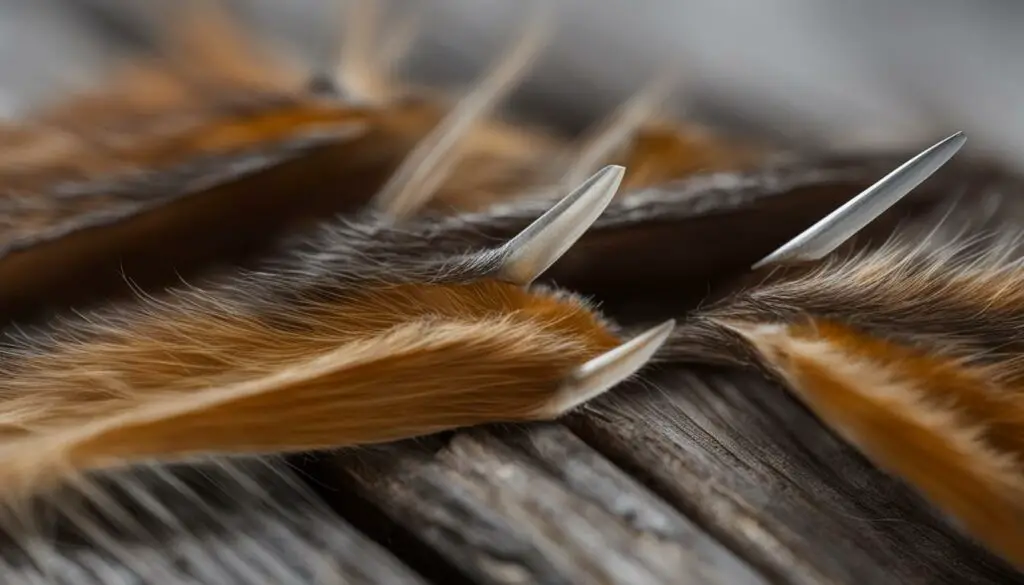
Tips for Protecting Your Furniture from Scratching
When it comes to cat scratching, prevention is key. By taking proactive measures, you can protect your furniture and redirect your cat’s scratching behavior to more appropriate surfaces. Here are some tips to help you safeguard your furniture:
Provide designated scratching surfaces:
Ensure your cat has access to scratching posts or pads in areas where they tend to scratch. These surfaces should be stable, tall enough for stretching, and made of materials that mimic tree bark or rough textures. By providing attractive alternatives, you can entice your cat away from your furniture.
Use deterrents:
Consider using deterrents to discourage your cat from scratching on furniture. Double-sided tape or specially formulated sprays can make surfaces less appealing to your cat. Apply these deterrents to furniture edges or areas your cat frequents. With consistent use, your cat will learn to avoid those surfaces and focus on their designated scratching posts.
Trim and dull your cat’s claws:
Regularly trimming your cat’s claws can help reduce scratching damage. Trim the sharp tips of the nails to prevent them from snagging on furniture. Dulling the claws can also help by making them less destructive. Use the proper technique and tools, or seek professional help if you are not confident in trimming your cat’s claws yourself.
Protect specific furniture pieces:
If there are particular furniture pieces that your cat is drawn to, consider using protective covers or blankets. These can provide a physical barrier between your cat’s claws and your furniture. Be sure to choose materials that are durable and easy to clean.
| Scratching Solutions | Benefits |
|---|---|
| Scratching posts | Provide an appropriate outlet for scratching, redirecting your cat away from furniture |
| Scratching pads | Offer a compact and portable scratching surface for cats |
| Double-sided tape | Makes furniture surfaces less appealing to cats, deterring scratching behavior |
| Citrus sprays | The smell of citrus can repel cats from scratching on furniture |
| Specially formulated deterrent products | Designed to discourage cats from scratching on furniture, with safe and non-toxic ingredients |
Remember, consistency is key when implementing these solutions. Provide your cat with alternative scratching options, use deterrents consistently, and regularly trim their claws to maintain a harmonious environment for both your cat and your furniture.
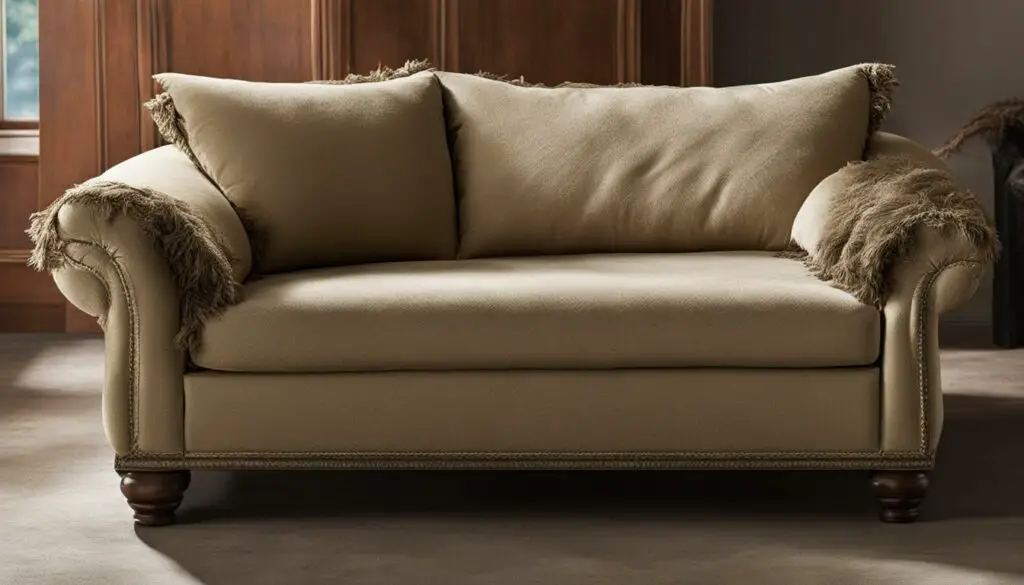
“Redirecting your cat’s scratching behavior to appropriate surfaces is essential for protecting your furniture while ensuring your cat’s needs are met.”
Alternatives to Dulling Cat Claws
While trimming your cat’s claws is a common method for keeping them dull and safe, it may not be suitable for every cat or owner. If you’re uncomfortable with the idea of trimming or your cat isn’t cooperative, there are alternative options available to help protect your furniture and keep your cat’s claws in check.
Nail caps are a popular alternative to trimming cat claws. These caps, such as Soft Paws, are small covers that can be glued onto your cat’s claws to prevent scratching damage. They are safe and comfortable for your cat when applied correctly and can last for several weeks. Nail caps come in various sizes and colors, allowing you to find the perfect fit for your cat.
Another alternative is providing your cat with a variety of scratching surfaces. Investing in a cat scratcher or scratching post can provide an outlet for your cat’s natural scratching behavior. Ensure the scratching surface is sturdy and appealing to your cat by choosing a material they enjoy, such as sisal rope or cardboard. Place the scratching surface in an area where your cat tends to scratch, and use positive reinforcement to encourage them to use it.
| Alternative | Advantages | Disadvantages |
|---|---|---|
| Nail Caps | – Protects furniture from scratching – Safe and comfortable for cats – Lasts for several weeks |
– Application process may take time – Caps need to be replaced as the claws grow |
| Scratching Surfaces | – Provides an outlet for natural scratching behavior – Reduces the need for regular claw trimming |
– May require training and positive reinforcement – Some cats may prefer specific materials |
Remember, it’s essential to observe your cat’s behavior and preferences to determine which alternative is the most suitable for them. If you’re unsure, consult with your veterinarian or a professional cat groomer who can provide guidance based on your cat’s specific needs. By exploring these alternatives, you can find a solution that works best for both you and your feline companion, promoting a harmonious living environment.
The Importance of Regular Claw Maintenance
Proper claw maintenance is crucial to ensure the overall well-being of your cat. Regular inspection and trimming of your cat’s claws help prevent overgrowth, reduce the risk of injury, and promote healthy scratching habits. By incorporating regular claw maintenance into your cat’s grooming routine, you can keep their claws in optimal condition.
Cats naturally need to scratch to mark territory, stretch, and remove the dead outer layer of their claws. Providing appropriate scratching options, such as a scratching tree or post, can help redirect their scratching behavior away from your furniture. Regular claw trimming complements these scratching alternatives by keeping the nails at a safe length.
To effectively maintain your cat’s claws, it’s important to gently grasp each paw and use a pair of sharp nail clippers to trim the sharp tip of the nail. Take care not to cut too close to the quick, as it can cause bleeding and discomfort. If you’re unsure or uncomfortable with the process, consulting a professional groomer or veterinarian can ensure a safe and stress-free trimming experience.
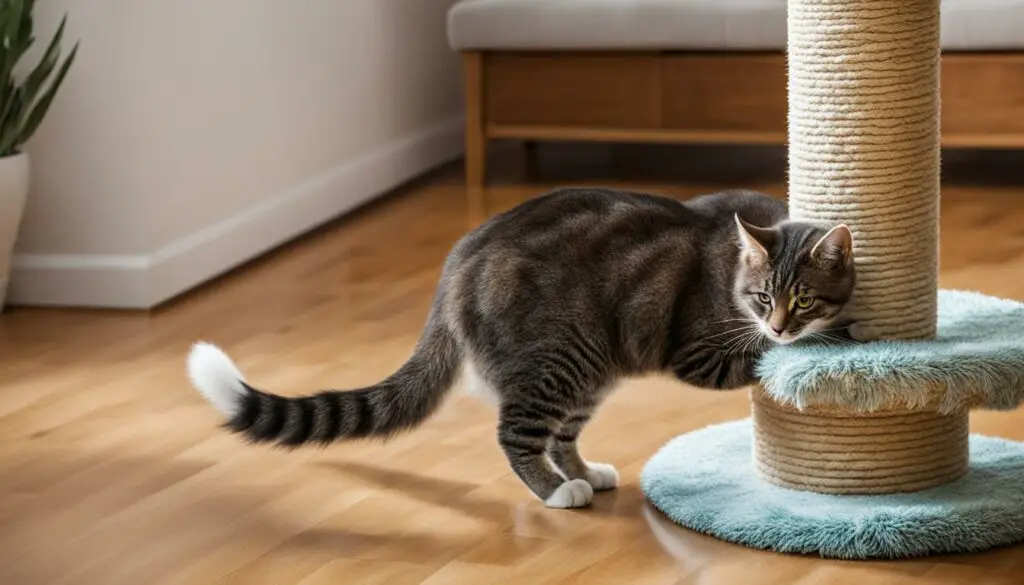
Benefits of Regular Claw Maintenance:
- Promotes safe and healthy scratching habits
- Reduces the risk of scratches and injuries for both pets and owners
- Prevents furniture and household item damage
- Enhances your cat’s overall well-being
Remember, every cat is unique, and their claw maintenance needs may vary. Regularly observe your cat’s scratching habits and monitor the length of their claws. By providing appropriate scratching options, practicing regular claw maintenance, and seeking professional help when needed, you can ensure that your cat’s claws remain healthy and their scratching behaviors are kept in check.
Understanding Cat Scratching Behavior
Understanding why cats scratch is essential in addressing their scratching needs effectively. Scratching is a natural behavior that serves multiple purposes for cats. It helps them mark their territory, stretch their muscles, and remove the dead outer layer of their claws. By providing appropriate scratching surfaces and understanding the underlying reasons behind their behavior, you can redirect their scratching tendencies and prevent unwanted damage to furniture and other surfaces.
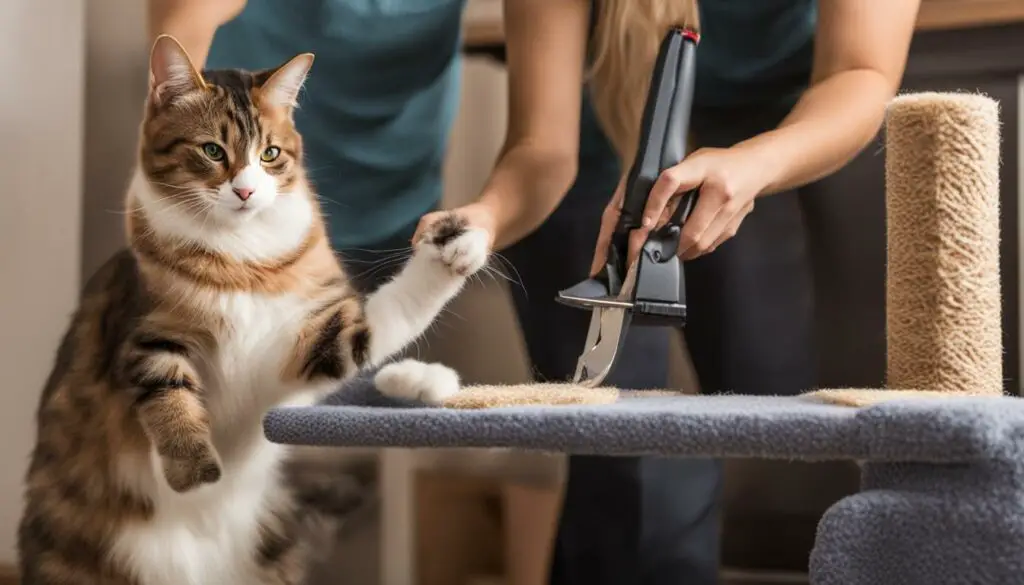
One way to satisfy your cat’s scratching needs is by providing cat scratching pads or mats. These surfaces give cats an appropriate outlet for their scratching behavior. Place the scratching pad or mat near areas where your cat has previously scratched furniture or carpet, as this will entice them to use the designated surface instead. Encourage your cat to use the scratching pad by gently guiding their paws onto it and rewarding them with praise or treats when they engage with it.
If your cat continues to scratch furniture despite the presence of scratching pads, you can use cat scratching deterrents. These deterrents come in various forms, such as sprays, tapes, or mats, and are designed to discourage cats from scratching on specific surfaces. Spraying a cat scratching deterrent on furniture or applying a double-sided tape can create an unpleasant texture or scent that cats dislike, redirecting their scratching behavior to more acceptable areas.
| Benefits of Cat Scratching Pads | Benefits of Cat Scratching Deterrents |
|---|---|
|
|
Understanding and accommodating your cat’s scratching behavior is key to creating a harmonious environment for both your feline friend and your furniture. By providing appropriate scratching surfaces, using deterrents when necessary, and redirecting their behavior, you can ensure that your cat’s natural instincts are satisfied while protecting your home.
Additional Tips for Claw Health and Nail Care
When it comes to keeping your cat’s claws healthy and well-maintained, there are a few additional tips you can follow. These tips will help you ensure that your cat’s claws remain in optimal condition, promoting their overall nail care and preventing any potential issues that may arise.
Regular Inspections and Cleaning
Regularly inspecting your cat’s claws is a crucial part of claw care. Take the time to examine each claw and remove any debris or dirt that may have accumulated. This will prevent any potential infections or discomfort for your cat. Use a clean, damp cloth or a soft bristle brush to gently clean the claws. Be sure to dry them thoroughly to prevent moisture from getting trapped, which could lead to fungal growth.
Additionally, if you notice any abnormalities, such as overgrown or ingrown claws, it’s important to seek veterinary care promptly. Your veterinarian can provide the necessary treatment and guidance to address any issues and keep your cat’s claws in optimal health.
Proper Nutrition for Nail Health
A well-balanced diet plays a vital role in maintaining your cat’s overall nail health. Ensure that your cat’s diet includes essential nutrients, such as protein, vitamins, and minerals, which contribute to healthy nail growth. Consult with your veterinarian to determine the best diet for your cat’s specific needs. By providing proper nutrition, you can support the development of strong and healthy nails.
Engage in Regular Play and Exercise
Regular play and exercise are not only beneficial for your cat’s overall well-being but also help to naturally wear down their claws. Engage your cat in interactive play sessions using toys that encourage scratching and stretching. This will help keep their claws naturally filed down and prevent them from becoming overgrown or too sharp. Additionally, providing a scratching post or a variety of scratching surfaces will give your cat the opportunity to satisfy their natural scratching instincts, promoting healthy claw maintenance.
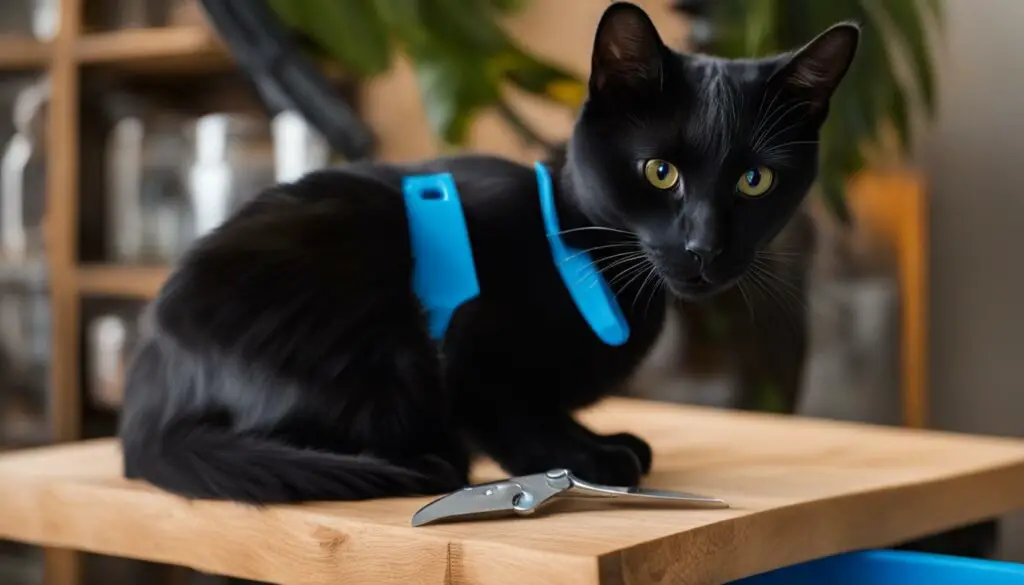
| Tip | Description |
|---|---|
| Use Cat Nail Clippers | Invest in a pair of cat-specific nail clippers that are sharp and designed for safe and precise trimming. Dull or improper clippers can cause pain and injury to your cat. |
| Avoid Cutting Too Close to the Quick | When trimming your cat’s claws, be careful not to cut too close to the quick, which is the sensitive part of the nail. Cutting into the quick can cause bleeding and pain. |
| Introduce Positive Reinforcement | Associate nail trimming with positive experiences by offering treats or rewards before and after the process. This will help create a positive association and make the experience more enjoyable for your cat. |
| Seek Professional Help if Needed | If you’re unsure about trimming your cat’s claws or if your cat is particularly resistant, it’s best to seek professional help from a veterinarian or a professional groomer who can expertly trim your cat’s claws. |
Protecting Your Cat’s Environment from Scratching
As responsible cat owners, we understand the importance of protecting our furniture and creating a safe environment for our feline friends. One of the key aspects of achieving this is by implementing effective cat scratching deterrents. These deterrents help redirect your cat’s scratching behavior to appropriate surfaces, saving your furniture from damage and ensuring your cat’s well-being.
One popular cat scratching deterrent is a cat scratching deterrent spray. These sprays are specifically formulated to repel cats from scratching on surfaces that are off-limits. By applying the spray to your furniture or other prohibited areas, you can effectively discourage your cat from scratching in those areas. Be sure to choose a spray that is safe for both your cat and your furniture.
Another option for protecting your furniture is cat scratching deterrent tape. This tape is designed to be applied directly to your furniture to create a deterrent surface that cats dislike. With its sticky texture, it provides an unpleasant sensation that cats want to avoid. The tape can be easily removed without causing any damage to your furniture.
If you have specific pieces of furniture that your cat frequently targets, you may consider investing in cat scratching deterrent furniture. These products are specially designed to protect your furniture from scratching damage. They typically feature a durable and scratch-resistant surface that cats can safely scratch on, redirecting their behavior away from your valuable furniture.
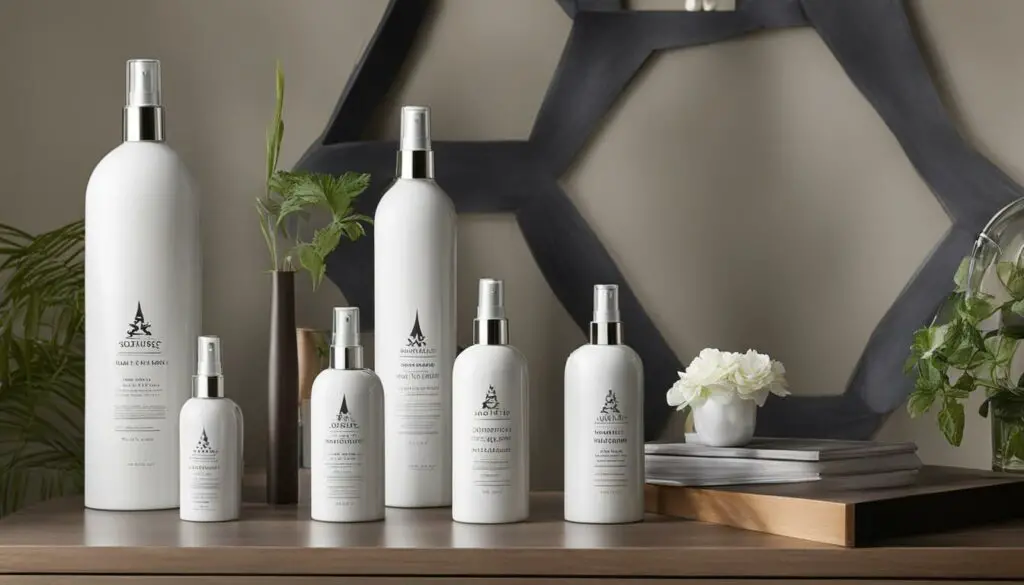
Table: Comparison of Cat Scratching Deterrent Options
| Product | Description | Effectiveness |
|---|---|---|
| Cat Scratching Deterrent Spray | A spray that repels cats from scratching on prohibited surfaces. | Effectiveness may vary depending on the cat’s preferences. |
| Cat Scratching Deterrent Tape | Adhesive tape to discourage scratching on furniture. | Provides a physical barrier that cats dislike. |
| Cat Scratching Deterrent Furniture | Specially designed furniture that cats can scratch on without causing damage. | Offers a dedicated scratching surface to redirect scratching behavior. |
Exploring Safe and Effective Claw Trimming Techniques
When it comes to safely trimming your cat’s claws, there are various techniques you can explore to make the process smoother and more manageable. One homemade deterrent that you can try is a citrus spray. Cats are often repelled by the scent of citrus, so spraying a mixture of water and citrus juice on areas you want to protect can help deter them from scratching. Another natural alternative is providing attractive scratching alternatives. Cats are more likely to scratch surfaces that are appealing to them, so investing in a cat scratching post or mat that suits their preferences can redirect their scratching behavior.
Additionally, incorporating positive reinforcement can make claw trimming a more positive experience for your cat. Give your feline friend treats and praise during and after the trimming session to create a positive association. This will help your cat associate claw trimming with rewards and may reduce their resistance to the process over time. Remember, patience and consistency are key when introducing new techniques, so give your cat time to adjust and be consistent in your approach.
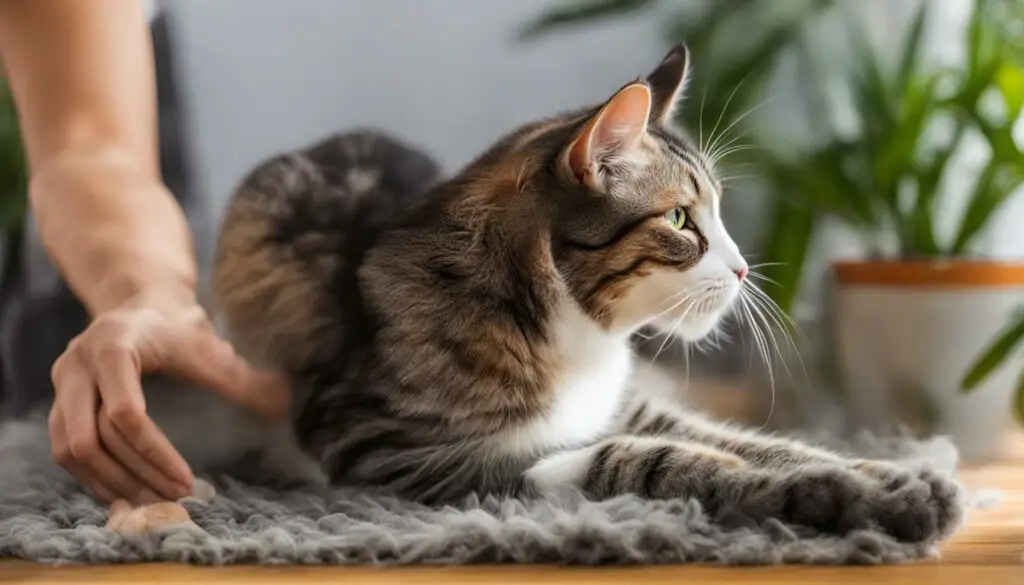
It’s important to note that not all techniques work for every cat, so experimentation may be necessary to find the most effective approach for your furry friend. Observe your cat’s response to different techniques and adjust accordingly. What works for one cat may not work for another, so it’s essential to tailor your approach to your cat’s individual needs and preferences.
By exploring safe and effective claw trimming techniques, you can make the process more enjoyable for both you and your cat. Whether it’s using homemade deterrents, providing attractive scratching alternatives, or incorporating positive reinforcement, finding the right approach can help you maintain your cat’s claws and protect your furniture from unwanted scratching.
Conclusion
In conclusion, the safe and effective dulling of cat claws at home is crucial for both your cat’s well-being and the protection of your furniture. By following the expert tips and techniques shared in this guide, you can ensure a stress-free and successful claw trimming experience. Remember to create a comfortable environment for your cat, use the proper tools, and approach the process with patience and care.
Regular maintenance and observation of your cat’s claws will help keep them healthy and prevent scratching damage. By incorporating appropriate scratching surfaces and providing alternative options, you can redirect your cat’s scratching behavior and protect your furniture. Additionally, consider seeking professional help if needed or exploring alternatives such as nail caps or varied scratching surfaces.
Remember, maintaining your cat’s claws is just one aspect of their overall nail care. Regular playtime, a balanced diet, and proper grooming practices all contribute to your cat’s well-being. By incorporating these practices into your cat’s routine, you can ensure their claws remain healthy and well-maintained while fostering positive scratching behaviors.
I hope this expert guide has provided valuable insights and useful techniques to help you safely dull your cat’s claws at home. With these practices, you can maintain a harmonious environment for both your feline friend and your furniture.
FAQ
What tools do I need to dull my cat’s claws?
To properly trim your cat’s claws, you will need a pair of sharp nail clippers designed for cats and a nail file to round out any sharp edges.
How can I get my cat comfortable with claw trimming?
It’s important to create a comfortable environment and introduce your cat to nail trimming gradually, using positive reinforcement and short sessions.
What is the proper technique for dulling cat claws?
Gently grasp your cat’s paw and use your fingers to squeeze the joint behind the claw. Cut only the sharp tip of the nail, avoiding cutting too close to the quick.
When should I seek professional help for claw trimming?
If you’re uncomfortable or your cat isn’t cooperative with nail trimming, it’s best to seek professional help from veterinary clinics or groomers.
How can I protect my furniture from scratching?
Provide designated scratching surfaces, use deterrents like double-sided tape or citrus sprays, and redirect your cat’s scratching behavior with appropriate options.
What are the alternatives to dulling cat claws?
Nail caps, such as Soft Paws, can be applied to your cat’s claws to prevent scratching damage. Providing a variety of scratching surfaces can also help fulfill their scratching needs.
Why is regular claw maintenance important?
Regular claw maintenance reduces the risk of injury, prevents overgrowth, and promotes healthy scratching behavior.
How can I protect my cat’s environment from scratching?
Use deterrent sprays or tapes designed for cats and consider using furniture protection products to safeguard specific furniture pieces.
What are some safe and effective claw trimming techniques?
You can explore techniques like homemade deterrents or natural alternatives to make the claw trimming process smoother and more manageable.
What additional tips can I follow for claw health and nail care?
Keep your cat’s claws clean, provide a balanced diet, and engage in regular exercise and playtime to naturally wear down their claws.




